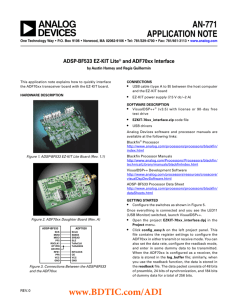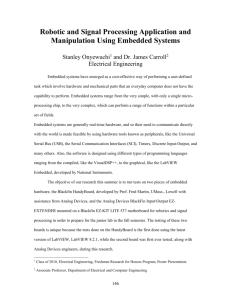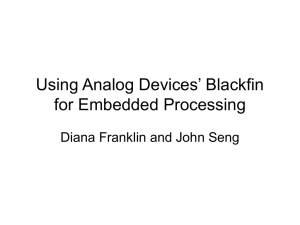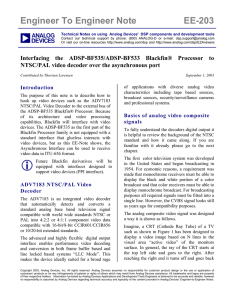a Engineer-to-Engineer Note EE-236
advertisement
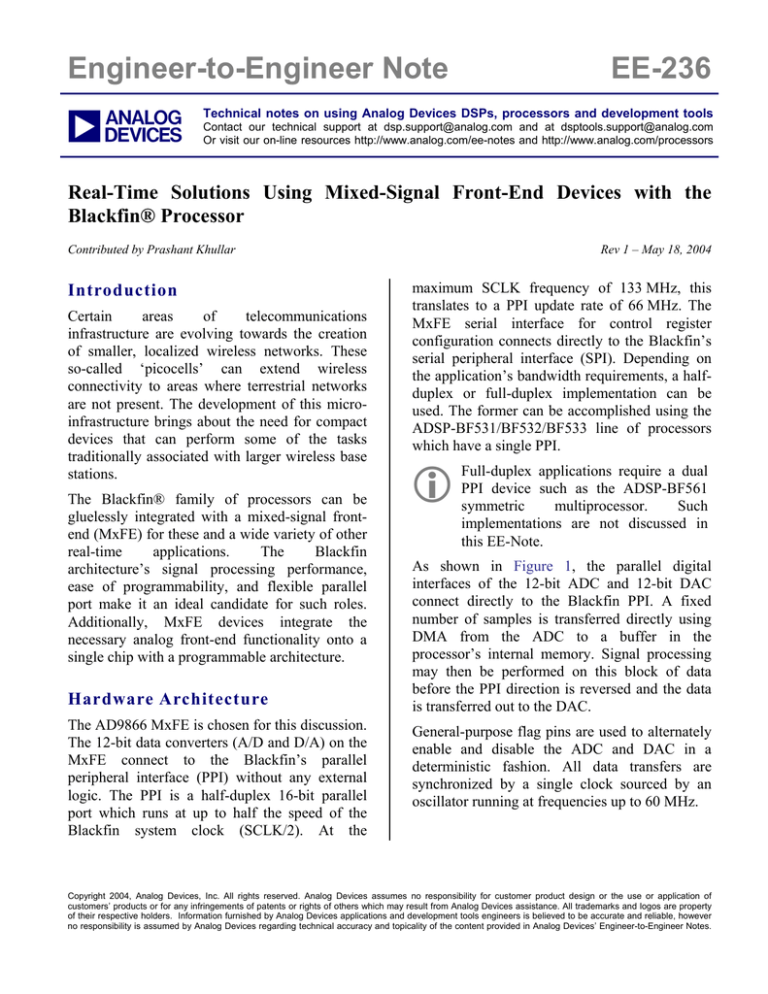
Engineer-to-Engineer Note a EE-236 Technical notes on using Analog Devices DSPs, processors and development tools Contact our technical support at dsp.support@analog.com and at dsptools.support@analog.com Or visit our on-line resources http://www.analog.com/ee-notes and http://www.analog.com/processors Real-Time Solutions Using Mixed-Signal Front-End Devices with the Blackfin® Processor Contributed by Prashant Khullar Introduction Certain areas of telecommunications infrastructure are evolving towards the creation of smaller, localized wireless networks. These so-called ‘picocells’ can extend wireless connectivity to areas where terrestrial networks are not present. The development of this microinfrastructure brings about the need for compact devices that can perform some of the tasks traditionally associated with larger wireless base stations. The Blackfin® family of processors can be gluelessly integrated with a mixed-signal frontend (MxFE) for these and a wide variety of other real-time applications. The Blackfin architecture’s signal processing performance, ease of programmability, and flexible parallel port make it an ideal candidate for such roles. Additionally, MxFE devices integrate the necessary analog front-end functionality onto a single chip with a programmable architecture. Hardware Architecture The AD9866 MxFE is chosen for this discussion. The 12-bit data converters (A/D and D/A) on the MxFE connect to the Blackfin’s parallel peripheral interface (PPI) without any external logic. The PPI is a half-duplex 16-bit parallel port which runs at up to half the speed of the Blackfin system clock (SCLK/2). At the Rev 1 – May 18, 2004 maximum SCLK frequency of 133 MHz, this translates to a PPI update rate of 66 MHz. The MxFE serial interface for control register configuration connects directly to the Blackfin’s serial peripheral interface (SPI). Depending on the application’s bandwidth requirements, a halfduplex or full-duplex implementation can be used. The former can be accomplished using the ADSP-BF531/BF532/BF533 line of processors which have a single PPI. ! Full-duplex applications require a dual PPI device such as the ADSP-BF561 symmetric multiprocessor. Such implementations are not discussed in this EE-Note. As shown in Figure 1, the parallel digital interfaces of the 12-bit ADC and 12-bit DAC connect directly to the Blackfin PPI. A fixed number of samples is transferred directly using DMA from the ADC to a buffer in the processor’s internal memory. Signal processing may then be performed on this block of data before the PPI direction is reversed and the data is transferred out to the DAC. General-purpose flag pins are used to alternately enable and disable the ADC and DAC in a deterministic fashion. All data transfers are synchronized by a single clock sourced by an oscillator running at frequencies up to 60 MHz. Copyright 2004, Analog Devices, Inc. All rights reserved. Analog Devices assumes no responsibility for customer product design or the use or application of customers’ products or for any infringements of patents or rights of others which may result from Analog Devices assistance. All trademarks and logos are property of their respective holders. Information furnished by Analog Devices applications and development tools engineers is believed to be accurate and reliable, however no responsibility is assumed by Analog Devices regarding technical accuracy and topicality of the content provided in Analog Devices’ Engineer-to-Engineer Notes. a Figure 1. Hardware Interconnection The serial connection between the Blackfin and AD9866 is used to program the MxFE’s onboard register set. These registers control various aspects of the device’s operation including power management, clocking, programmable gain amplifiers, and interpolation filters. Software-Controlled Data Flow To implement such a half-duplex communication scheme, the PPI and DMA controller on the Blackfin processor need to reverse their direction of data transfer at specified intervals. This can be accomplished in software using a block of configuration code placed in an interrupt service routine (ISR). In the tested implementation, a general-purpose timer was used to generate the interrupts that trigger this routine at deterministic intervals. The timer period was chosen empirically such that the time between successive interrupts was adequate to ensure that the ongoing DMA transfer is able to complete and that the ‘turnaround’ code is also able to execute to completion. The latency associated with the DMA/PPI turnaround code has two components. The first is the time associated with switching context between the main execution flow and the ISR. The delay involved with reconfiguring the GPIO, DMA, and PPI register sets constitutes the remainder of the turn-around time. The subsequent quantitative analysis of this dataflow uses the following abbreviations: N: Number of Samples (Data Window Size) CCLK: Blackfin Core Clock Frequency SCLK: Blackfin System Clock Frequency DCLK: Data Clock/PPI Clock (synchronizes MxFE converters and PPI) RX 0, RX 1: first and second halves of the received data window, respectively TX 0, TX 1: first and second halves of the transmitted data window, respectively P0, P1: signal processing of first and second data window halves, respectively The following empirically: benchmarks were obtained Context Switch Latency (Using EX_InterruptHandler with the stack in L1 Data Memory) = ISR Initialization Latency + Real-Time Solutions Using Mixed-Signal Front-End Devices with the Blackfin® Processor (EE-236) Page 2 of 5 a ISR Termination Latency = 32 CCLK cycles signal processing tasks may be performed in parallel with DMA transfers. In particular, input and output data buffers are broken into halves so that one half may be processed while the other is being read or written by the DMA controller. GPIO/DMA/PPI Reconfiguration Latency = 25 SCLK + 73 CCLK cycles (223 CCLK cycles at a 6:1 SCLK:CCLK ratio) The following data-flow diagram and execution timeline illustrate this half-duplex ping-pong scheme. Total Turn-around Latency = 25 SCLK cycles + 105 CCLK cycles (255 CCLK cycles at a 6:1 SCLK:CCLK ratio) To boost processing efficiency, a ping-pong scheme is implemented in software, whereby ADSP-BF533 Core Processing PPI MxFE Converters PPI_Data [11:0] DMA Core Bus (DCB) DMA Access Bus (DAB) RX 0 Load Data RX 1 TX 0 DMA Store Data TX 1 DCB L1 Internal Memory Buffers Figure 2. Digital Dataflow Figure 3. Execution Timeline Real-Time Solutions Using Mixed-Signal Front-End Devices with the Blackfin® Processor (EE-236) Page 3 of 5 a ! For applications that require larger and variably-sized sample windows, the above data flow can be modified easily to place buffers in external SDRAM. using flag pins. The Blackfin processor acts as the master device by toggling flag pins connected to the Transmit Enable (TXEN) and Receive Enable (RXEN) pins of the AD9866. As demonstrated above, the turn-around latency reduces the available bandwidth minimally. The maximum throughput of this arrangement can be quantified as follows. The active-high RXEN and TXEN signals indicate when valid data is being read from the ADC or written to the DAC by the Blackfin PPI, respectively. These signals are not transmitted over the analog medium. Therefore, in this halfduplex scheme, an external device connected to the analog medium needs to be able to handle the alternating bursts of data transmission and reception. With CCLK = 750 MHz, SCLK = 125 MHz, DCLK = 60 MHz: Turnaround Latency = 255 CCLK cycles ≈ 20 DCLK cycles Average bandwidth lost to turn-around latency = [1/(20 DCLK cycles)]*2 Bytes = (DCLK/20)*2 Bytes = 6 megabytes/second Average RX Throughput = Average TX Throughput = [(DCLK/2) – (DCLK/20)]*2 Bytes = 54 megabytes/second Signal Processing The real-time processing workload that can be accommodated depends on the size of the data window. The time taken by the algorithm to complete must not exceed the deterministic time required for the parallel DMA transfer to complete. Appropriate selection of the window size is therefore essential. In general, signal processing algorithms that execute slower than in linear time become unmanageable as the window size grows large. On the other hand, algorithms that execute faster than in linear time may be more efficient to implement with large window sizes. The demonstrational example used to test this system performed a 512-point Fast Fourier Transform (FFT) followed by an inverse FFT of the same size on each half of the 1024-sample window. Both algorithms execute slower than in linear time (O(n log n)); therefore they can be expected to exceed the available processing time if the data window size is increased indefinitely. Half-Duplex Synchronization One possible implementation is for the device to have built-in circuitry to distinguish between valid data and silence. A simple dead-band circuit, which enables data sampling after a certain analog voltage threshold is exceeded, would be appropriate. Additionally, the device would need to be programmed to receive and transmit data bursts of a pre-specified length. When interfacing to external devices that require explicit data framing, the TXEN and RXEN signals can be transmitted alongside the analog signals. Implementation The hardware components and configuration required to evaluate this design are outlined in the readme.txt file included in the VisualDSP++® project that accompanies this EE-Note. A glueless 3-board interconnection is required. The AD9866 Evaluation Board connects directly to the ADSP-BF533/BF561 EZ-Extender card, which interfaces to the ADSP-BF533 EZ-KIT Lite™ Evaluation Board. The VisualDSP++ software module that demonstrates the hardware’s functionality is written entirely in embedded C. It provides a proof-of-concept with enough flexibility and modularity to fit a wide range of applications. Data transfers between the AD9866’ high-speed converters and the Blackfin PPI are synchronized Real-Time Solutions Using Mixed-Signal Front-End Devices with the Blackfin® Processor (EE-236) Page 4 of 5 a Conclusion With bidirectional throughput of over 50 megabytes/second, a flexible programming model, and ample processing headroom, the halfduplex interconnection of a Blackfin processor and MxFE is particularly well-suited to low-cost wireless infrastructure. Moreover, it is general enough to be used for any number of real-time applications. References [1] ADSP-BF533 Blackfin Processor Hardware Reference. Revision 1.0, November 2003, Analog Devices Inc. [2] AD9866 12-bit Broadband Modem Mixed Signal Front End Datasheet. Revision 0.0, November 2003. Analog Devices Inc. Document History Revision Description Rev 1 – May 18, 2004 by P. Khullar Initial Release Real-Time Solutions Using Mixed-Signal Front-End Devices with the Blackfin® Processor (EE-236) Page 5 of 5
